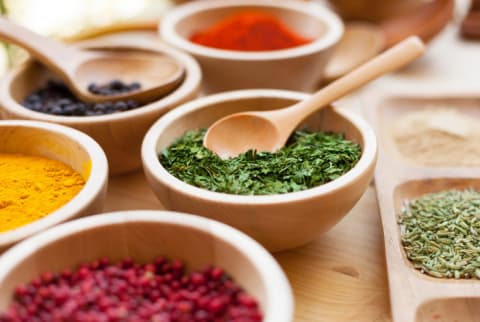Advertisement


There's nothing inspiring about a bowl of bland, flavorless quinoa. Sure, it might be “healthy,” but where's the joy? Where’s the pleasure?
I’m a firm believer that, first and foremost, food needs to be delicious. As a professional chef, I’ve watched the Internet explode with endless amounts of healthy recipes. And while there are a lot of great ideas and dishes out there, I find that the little tricks based on generations of tradition are often overlooked.
Armed with a little knowledge, some specialty tools, and a well-tuned palate, you can turn the ordinary into the extraordinary.
1. Season, season, season.
One of the most common mistakes home cooks make is not being assertive enough with seasoning. Often a little extra salt, pepper, and lightly chopped herbs will go a long way toward bringing out the natural flavors of a dish.
Just imagine a roast chicken without salt and pepper. (Blech!) Add some sea salt, cracked pepper, crushed thyme and rosemary, lemon zest, and maybe even some coriander and sesame seeds, and suddenly that pedestrian bird becomes a Middle Eastern masterpiece!
2. Consider the four elements.
Salty, sweet, sour, spicy — these are the compass points of a dish. Playing spicy off sweet (think mango and chilies) or sour off salty (this is why salt and vinegar potato chips are so addictive) can make a dish balanced and craveworthy.
I don’t always have these elements in equal parts. Sometimes you want one flavor profile to dominate the others, but having a balance makes for a successful and exciting dish.
3. Embrace the microplane.
Italian chefs know the microplane grater is the perfect tool for grating aged Parmesan, but there are many other ways to use it.
My favorite is finishing a dish with a quick zest of citrus. A little lemon brings a salad to life; lime gives a bright, floral and unexpectedly tropical jolt of flavor; and even grapefruit and orange are brilliant.
Ideally, I choose organic citrus (conventional citrus can have pesticide residue) and always wash the fruit before zesting. Try a roasted beet salad with grapefruit segments, pistachios, and a little grapefruit zest as a garnish.
I also use a microplane to grate a little garlic into a vinaigrette or some gently steamed or sautéed greens.
4. Remember: Blanch isn't just one of the Golden Girls.
Blanching just means bringing a large pot of well-salted water (think seawater!) to a boil and quickly cooking vegetables until they're about 70 percent cooked.
A few things to remember when blanching:
- Blanch vegetables in small batches.
- Allow the water time to recover and come back up to a boil.
- Keep the water at a strong rolling boil.
If you're making a dish with several vegetables, you can blanch each vegetable briefly, then add them to a sauté pan at different stages of cooking to ensure everything is cooked perfectly. This makes each element healthier and tastier.
5. Operation Shock and Mmm.
This goes hand in hand with blanching. The cooking process doesn’t actually stop when you turn off the stove, as foods retain residual heat and will continue to cook, even off the heat.
The solution? "Shock" vegetables in an ice bath.
How to do it:
- Boil a big pot of water.
- Prep vegetables.
- Prepare a large ice bath. Aim for a 60/40 ratio of ice to cold water. (It’s important to use really cold ice water if you want to stop the cooking.)
- Place vegetables in the boiling water, then immediately place them in the ice bath.
- Strain and pat-dry your vegetables. Then either cook them right away, or set them aside for later.
6. Pack on the pressure.
There's probably no kitchen tool as underappreciated as the pressure cooker. It wasn’t until competing on Iron Chef that I realized just how much of a time saver a pressure cooker can be.
Dried beans in 20 minutes or braised lamb shanks in 35 minutes — it’s an amazing way to cook a quick meal.
I like to prepare my ingredients in the morning, then when I come home, dinner is ready in 15 minutes. As we head toward the colder months, it’s the ideal tool for making hearty winter stews.
7. Spiralize it.
The spiralizer is a Japanese lathe that turns zucchini (and other vegetables) into pasta-like strips. These interesting shapes add a whole new dimension of texture to food.
I love using it to make ribbons of summer squash for a cold salad with some crab and avocado, a little chili powder and fresh herbs. Add a squeeze and zest of citrus and you’ve got an amazing, healthy, and delicious weekend lunch.
8. Low and gentle.
In summer, I love cooking vegetables with just a little heat and infused olive oil.
I’ll throw dried chili powder, thyme, and lemon peel into a splash of olive oil and heat it over medium-low before adding some cherry tomatoes, summer squash, and snap peas.
By maintaining a low heat and gently sweating the vegetables, the colors stay bright and flavors and textures remain delicate. Crack a few fresh eggs into the pan, lightly scramble, and you’ve got a perfect lunch or breakfast.
Watch Next
Enjoy some of our favorite clips from classes
Enjoy some of our favorite clips from classes
What Is Meditation?
Mindfulness/Spirituality | Light Watkins
Box Breathing
Mindfulness/Spirituality | Gwen Dittmar
What Breathwork Can Address
Mindfulness/Spirituality | Gwen Dittmar
The 8 Limbs of Yoga - What is Asana?
Yoga | Caley Alyssa
Two Standing Postures to Open Up Tight Hips
Yoga | Caley Alyssa
How Plants Can Optimize Athletic Performance
Nutrition | Rich Roll
What to Eat Before a Workout
Nutrition | Rich Roll
How Ayurveda Helps Us Navigate Modern Life
Nutrition | Sahara Rose
Messages About Love & Relationships
Love & Relationships | Esther Perel
Love Languages
Love & Relationships | Esther Perel

















